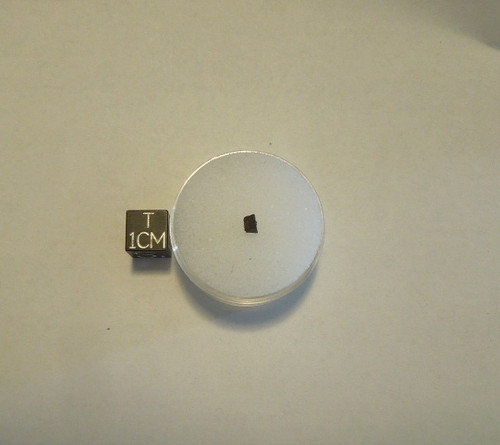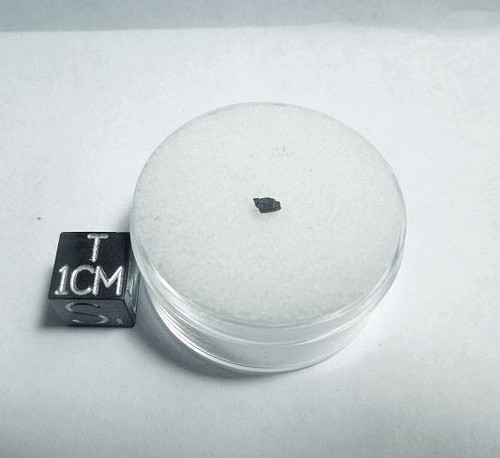In 2016, an extensive meteorite strewnfield was discovered in the remote Sahara near the city of Agadez in Niger. Hundreds of distinctive stones with a similar appearance were found across a wide area. When cut open, the stones were very metal-heavy with prolific amounts of metal flecks, melt veins, and nodules scattered across a black matrix with tiny vesicles scattered throughout. This meteorite first appeared on the market as “Tchifaddine” and it was widely traded with this name until they were classified as a H5-melt breccia and given the official name of “Tassedet 004”.
These specimens have that “starry night” look to the slices – dark matrix (sky) packed with glittering metal flecks (stars).
The specimen being offered here is a single small micromount fragment.
Refer to the photo. The black centimeter cube is shown for scale and is not included. You are purchasing a fragment like the one shown. Your purchase will include a labeled gemjar for safe storage.
From the Meteoritical Bulletin entry on Tassedet 004 (Tchifaddine) :
Tassédet 004 ~18°40’30"N, ~7°23’53"E
Agadez, Niger
Find: 2016
Classification: Ordinary chondrite (H5, melt breccia)
History: A large stone of 405 kg was found around 5 km SE of Akokan. It is probably part of a large strewnfield extending for kilometers. Tassédet 004 is widely traded under the name "Tchifaddine."
Physical characteristics: Interior shows little to no signs of weathering. Exterior largely dark colored with protruding metal clasts, typically cm-sized.
Petrography: Examination of multiple kg of material shows considerable variation in petrography and clast size. This description is based on two representative slices (10 × 8 cm and 18 × 18 cm) and two polished microprobe mounts. The polished slices are dominated by black rounded clasts, surrounded by lighter-colored quenched melt and igneous-textured microporphyritic melt domains. The black clasts show an even distribution of metal and sulfide, typically <500 μm across, and significant porosity as vesicles 10 to 200 μm, some with euhedral grains protruding into the voids. Rare melt pockets to 100 μm. In the two sections, the chondrules in the black clasts are largely integrated into the matrix. A few PO and BO chondrules were recognized. The silicates contain an abundance of small, <1 μm, sulfide and metal grains. Clast metal dominated by kamacite, lacks Neumann bands, is anhedral though with curved outlines. It is typically single crystal, though some show a lath-like martensitic texture. Most kamacite grains have a "frothy" coating of troilite. Troilite is single crystal to polycrystalline and lacks shock lamellae. Metal/troilite grains >2 mm in the melt show eutectic textures. Grains smaller than 2 mm consist of Fe-Ni spheres with coatings of troilite. Chromite is a common accessory as anhedral grains to 200 μm. Feldspar, as anhedral grains, have a wide size distribution from <10 to >50 μm.
Geochemistry: (L. Garvie, ASU) Black clast: Olivine Fa19.3±1.2, range Fa18.5-22.1, FeO/MnO=39.9±2.9, CaO to 2.2 wt%, Cr2O3=0.1±0.03, range 0.04 to 0.14 wt%, n=9. Low Ca pyroxene, Fs16.7±0.9Wo1.8±0.5, FeO/MnO=23.4±2.5, n=10. Two high-Ca pyroxene grains found, Fs6.8Wo44.4 and Fs6.1Wo45.4. Feldspar Or2.0±0.4Ab76.2±0.9, n=5.
Classification: H5-melt breccia. Low weathering, W1, and high shock. Mineralogy and petrography are similar to the Gao-Guenie H5 melt breccia (Schmieder et al., 2016). Tassedet 004 is widely traded under the name Tchifaddine.





